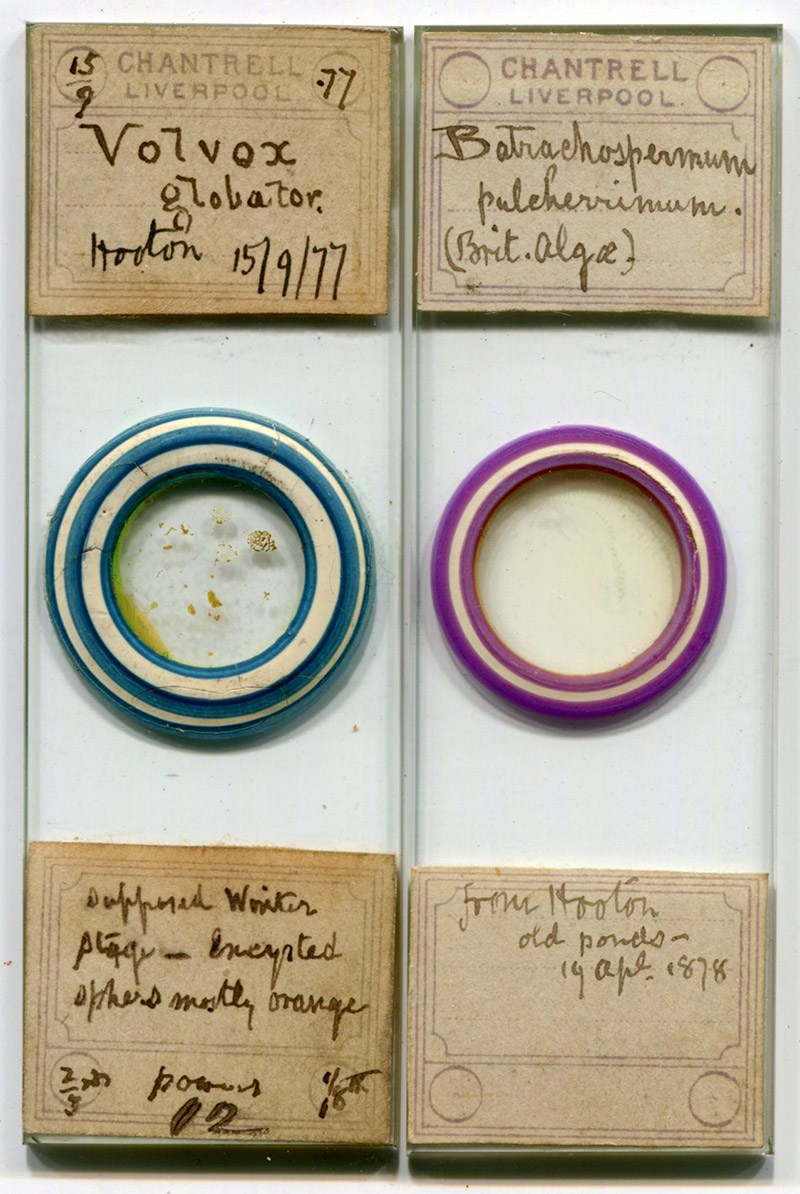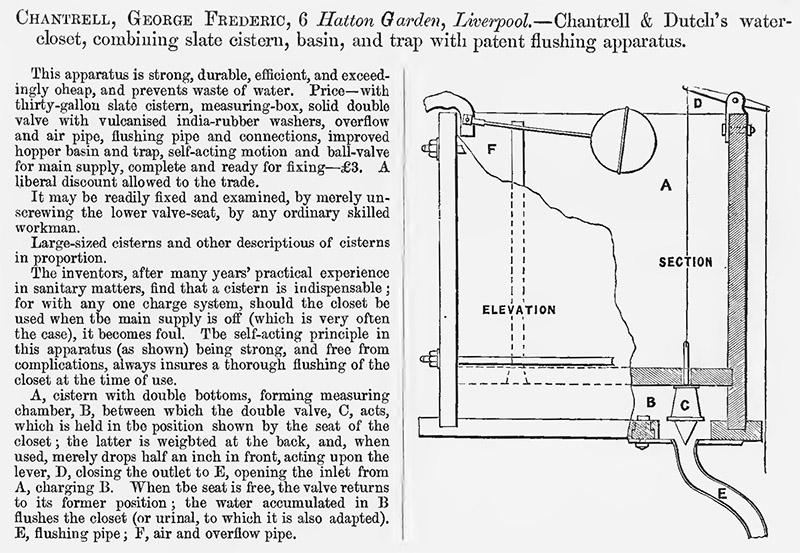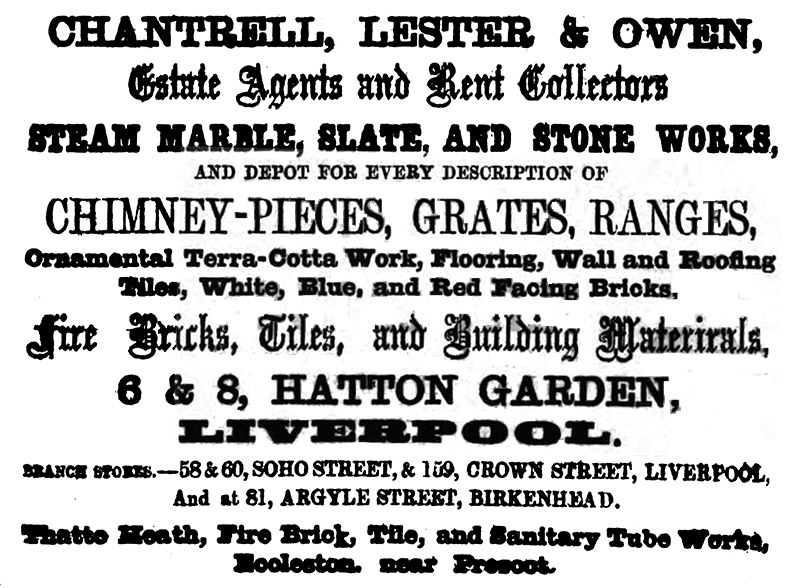George Frederic Chantrell, 1818 - 1883
by Brian Stevenson
last updated December, 2018
Mentioned, but not illustrated, in Bracegirdle’s Microscopical Mounts and Mounters, slides by this English amateur microscopist are relatively uncommon. Known examples of Chantrell’s work are nicely finished with colored ringing and professional-looking labels (Figure 1). He was very active during the 1870s, serving as President of the Liverpool Microscopical Society in 1878, and afterward as Vice President and Member of the Society’s Council. He also was a member of the Quekett Microscopical Club, joining in 1879.

Figure 1.
Examples of microscope slides that were prepared by G.F. Chantrell, dated 1877 and 1878. He gave presentations on Volvox globator to the Liverpool Microscopical Society in November, 1877 and June, 1878 - the slide on the left may have been prepared as part of his studies on that protozoan. The “Hooton” that is listed as the source of both materials was probably Charles Hooton, who lived in the London area and was a member of the Quekett Microscopical Club.
George Chantrell’s father was the architect Robert Dennis Chantrell (1793-1872), whose notable designs include the current version of St. Peter’s Church in Leeds, Yorkshire (completed in 1842). George was christened in the previous St. Peter’s, on March 4, 1822, although he was born on July 15, 1818, in Halifax, Yorkshire. He was the third child, and second son, of Robert and his first wife, Elizabeth.
George married Ann Stuart during the spring of 1843, in her hometown of Wolverhampton, Staffordshire. Chantrell was probably then working as a stock broker in Leeds, in partnership with a John Boyes. The partnership was dissolved in 1846, with each man continuing independently in the same line of work.
By 1851, George, Ann, and their first three children had moved to Tranmere, Cheshire, near Liverpool (they eventually had 8 children). The 1851 census listed his occupation as “Fire brick agent, merchant, engineer & contractor”. The 1861 census recorded the family in the Garston district of Liverpool. George was the owner of a prospering business that manufactured building materials. According to the 1861 census, he employed 110 men, 13 boys, and 3 girls.
He evidently had a strong interest in the arts and sciences by this time. He became a member of the Society of Arts in 1855.
Prior to 1861, Chantrell had travelled far beyond England: he told an anecdote of his travels to Russia at the February, 1861 meeting of the Liverpool Architectural Society. At that same meeting, he also revealed that he had relatives in Belgium, describing an invention by one of them, “The invention had been used for ventilating hospitals, prisons, and other large buildings. He had himself taken out a patent for this country, and his object was to apply it to smoky chimneys”. This was one of many patents filed by Chantrell through the years, among which was a novel water closet that he displayed at the 1862 London International Exhibition (Figure 2).
Chantrell’s entry in the 1862 Exposition lists only his name, implying that he was sole owner of the business. By 1864, he had a partnership with Messrs. Lester and Owen (Figure 3). In addition to manufacturing and selling construction materials, they also managed leases of buildings. This partnership ended by 1870, when directories listed Chantrell as sole owner of a construction supply company at 23 Hatton Garden, Liverpool. Owen operated a competing business, at the original site of 6 Hatton Garden. A partnership between George and his eldest son, Frederic, was formed in the mid-1870s, operating as “George F. Chantrell and Son”.
George Chantrell was an early member of the Liverpool Microscopical Society. His date of joining is not known, but he made a presentation on rotifers in 1870. An extended presentation on “The decomposition of animal and vegetable substances” was given to the Society in 1873. At that time, Chantrell served as Honourable Secretary.
He made another extensive presentation in 1877, "Recent observations on the development of animal life in vegetable protoplasm”. This focused extensively on studies in which "he had devoted some time to the careful study of the Volvox globator, and had examined a large number during the recent summer”. He followed during the summer of the next year with another lecture on Volvox, which included "mounted slides of the objects themselves by himself, and also stained specimens by Mr. James Abbott, of Leeds”. The slide of Volvox shown in Figure 1 dates from that time, and was probably part of Chantrell’s study material.
Chantrell was elected President of the Liverpool Microscopical Society in 1878. He served as Vice President for the following year.
He joined the Quekett Microscopical Club on April 25, 1879. It is not clear whether he attended meetings of that London-based club.
Chantrell’s investigations into protozoans and other microscopic organisms were described by fellow amateur microscopist John Butterworth in 1880, after a visit to Liverpool, “Other forms however still remain a puzzle, and before we can understand these very minute forms ‘which require a good 1/4 inch objective to view them distinctly’ we shall be compelled to study plants in decay, especially the aquatic species. I was forcibly struck with this fact while on a recent visit to Liverpool. Mr. Chantrell, with whom I stayed, has been engaged in this study ‘which he pleases to call the borderland of animal and vegetable life’ for ten or twelve years, and he showed me an extensive collection of drawings illustrating the changes he has observed while engaged in watching this decay of vegetable matter. He also put me preparations under the microscope of the same forms arrested in decay and mounted permanently for examination. I have no doubt that many of the forms Mr. Chantrell showed me are the winter states of different plants; see, for instance, the winter state of Volvox, as illustrated in works on Algae, &c.”
Chantrell’s studies did not extend for long after Butterworth’s visit. George died on February 19, 1883, at his home in St James’ Mount, Liverpool. Son Frederic closed the building materials business the year after.

Figure 2.
Description of George Chantrell’s entry in the 1862 London International Exposition.

Figure 3.
An 1864 advertisement for George Chantrell’s building materials partnership.
Resources
American Journal of Microscopy and Popular Science (1879) Vol. 4, page 72
Bracegirdle, Brian (1998) Microscopical Mounts and Mounters, Quekett Microscopical Club, London, page 21
The Building News and Engineering Journal (1861) Vol. 7, pages 87-88
Butterworth, John (1880) The mineralisation of plants, Hardwicke’s Science-Gossip, Vol. 16, pages 162-163
Chantrell, George F. (1873) The decomposition of animal and vegetable substances, Pharmaceutical Journal, pages 912-913
The Commercial Directory of Liverpool (1871) page 166, R.E. Fulton, Liverpool
The Commercial Directory of Liverpool (1875) pages 197, 254, 262, and others, R.E. Fulton, Liverpool
England census and other vital records, accessed through ancestry.com
The English Mechanic and the World of Science (1878) Microscopical Society of Liverpool, Vol. 27, page 365
A. Green and Co.'s Directory for Liverpool and Birkenhead (1870) “Chantrell, G.F. building material merchant, 23, Hatton garden”, page 205
The Illustrated Catalogue of the Industrial Department, London International Exhibition (1862) page 48
Journal of the Quekett Microscopical Club (1879) “List of members … April 25, 1879 Chantrell, George F. (V.P. and late Pres. Liverpool Mic. Soc), 1 St. James's-mount, Liverpool”, Vol. 6
The Journal of the Society of Arts (1868) “List of members, with date of election … 1855. Chantrell, George Frederick, 6 Hatton garden, Liverpool”, Vol. 16, page 10
London Gazette (1846) Notice of the dissolution of Chantrell and Boyes, page 3196
The Monthly Microscopical Journal (1871) Vol. 5, page 41
The Monthly Microscopical Journal (1877) Vol. 17, page 54
Moore, Richard W. (1877) A History of the Parish Church of Leeds, from the Earliest Known Period Down to the Present Time, R.W. Moore, Leeds
Probate of George F. Chantrell (1883) “The Will of George Frederic Chantrell late of St James’ Mount in the City of Liverpool Builder’s Merchant who died 12 October 1883 at St James Mount was proved at Liverpool by Annie Chantrell of St James’ Mount Widow the Relict the sole Executrix. Personal Estate £556 5s 6d”, accessed through ancestry.com
Williams's Manufacturers' Directory, for London and Principal Market Towns in England (1864) Advertisement from Chantrell, Lester, and Owen at rear of book, J. Williams, London


